Bliss Charity Primary School

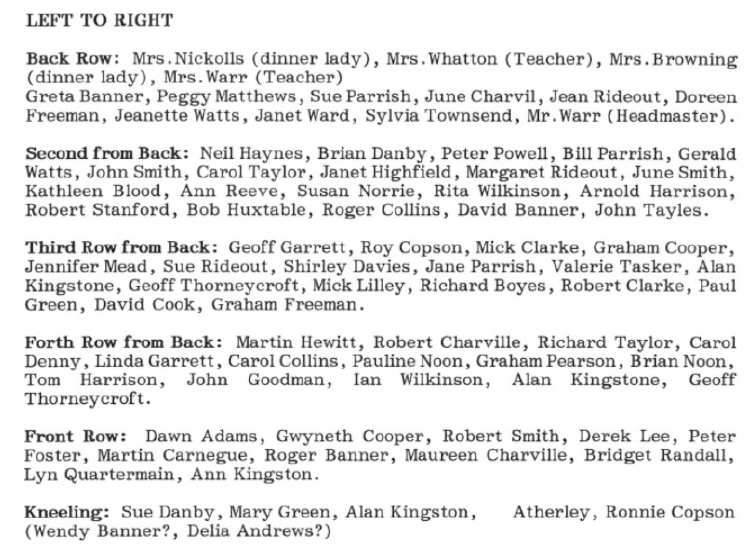
“Our Towns and Villages #45 Lower Heyford by Wayfarer”
Published in The Prattler – July & August 2020
Thanks to Shirley Collins
Bliss Charity Primary School


“Our Towns and Villages #45 Lower Heyford by Wayfarer”
Published in The Prattler – July & August 2020
Thanks to Shirley Collins
June 1954
Dear Diary,
There are lots of new homes going up in Hillside Road and Hillside Crescent and new families moving in, including my friend Jane who used to live at Novelty Farm on the A5. It’ll be great having her so near, although we’ll miss our games in the hay bales and with the animals. Apparently her new next door neighbour is to be presented with the “key of the door” to mark the 100th Council house to be completed and the newspaper reporters will be there to take photographs, how exciting is that?
The old cottages nearest the green in Close Road have been pulled down. At the other end of the road there is a five-barred gate close to a little stream that comes down from the hills. The water then goes under the road and comes up again to flow along in front of The Peak, along Hillside Road, down the side of the green and again underground as far as Watery Lane, which is how it got its name. It then finds its way to the river. We have so much water around the village with the river and the canal and all these little streams in between. Let’s hope it all stays on course.
The old Jubilee Hall is to be pulled down because it’s no longer safe. They are only leaving the little wall at the front. Where will everyone meet now? Maybe in The Foresters Arms, I’m sure Mr. Rolfe would be pleased to have them. I don’t think the couple at The Old Sun would have them. I sit in their kitchen sometimes while mum and dad go into the pub and they bring me a bottle of pop, Dandelion and Burdock is my favourite.
Our new Headmaster, Mr. Warr, and his wife have settled in nicely, Mrs. Hazel has left and Mrs. Whatton or Madam as we are to call her, has started, so some changes have been made. This afternoon we are getting ready for Sports Day on the village green. I’m not very good at sports so I shall try for the Sack Race or The Egg & Spoon Race. I know I won’t win either but I better show willing. At last the school has toilets inside the building so no traipsing up the yard next winter.
I’m going to dress as Maureen ‘Little Mo’ Connolly at the church fete Fancy Dress competition next weekend. At 16 she was the youngest tennis player to win at the US Open tournament. I love the church fete with stalls, games and tea on the lawn. Most of the villagers turn out for it.
Because it was warm yesterday me and my cousin played a game in the chicken house. We got covered in fleas so mum got the tin bath out of the barn, put it on the back lawn, filled it with warm water and made us have a strip wash to get rid of them before we went indoors. We did giggle. So much for our chicken army. We’ll pester the pigs next time, they’re cleaner.
Polly
Letter published in The Prattler – June 2020
In DESIRABLE FREEHOLD ESTATE
Consisting of The
MANOR or REPUTED MANOR
of
HEYFORD
Stone—Built Mansion or Manor House
with
Suitable Offices, Stabling, Gardens etc.
And
Sundry Eligible Farms with their Suitable Buildings
And
528A. 2R. 28P. of uncommon rich Arable, Meadow
Pasture and Wood Land
Let to Tenants on Leases which will expire at Lady Day next, at very low Old Rents (the Wood Lands in Hand included) of
FIVE HUNDRED AND NINETY~NINE POUNDS
These are how the Particulars and Conditions of Sale read on Thursday, February 2nd, 1792 at the Auction held by Mr Christie at his Great Room in Pall Mall. At that time a Fee Farm Rent, payable to the King was 3s. 4d, Land Tax for the whole of the Estate was £54.16s.0d and various Tithes to be paid meant total outgoings of ,£112.6s.9d. Part of the outgoings included an Annual Payment of £20 to the Hospital at Northampton, “out of which £4 is allowed in Land Tax”. The actual Manor House was much smaller than it is now — the East and West Wings came at the turn of the Century and the small ‘Garden House’ at the back, although keeping the original frontage and downstairs room complete with large stone fireplace, was added to as late as 1982.
The early estate
The original Manor House was at Upper Heyford and the remains of its foundations can still be seen. This was the Manor House of the Mauntells and Morgans, Prestons and Herbert Marquis of Powis and is supposed to have stood in the field called the Upper Park. John Mauntell of Heyford, descended from Michael Mauntell of ‘Rode’ married Elizabeth, daughter and heiress of John Lumley (also reputed to be of Heyford) and ‘levied fine of Heyford Manor’ in the reign of Henry VI (around 1446) and so founded a dynasty of Mauntells at Heyford.
Prior to the Mauntells the Tudenhams ruled the roost at Heyford (also ‘big’ in Suffolk; as you approach Bury St Edmunds you can see the village of Tudenham signposted) and presumably occupied the old Manor House, but we are going back to 1333 here and records are a little vague as to Lords of the Manor, but they were certainly large land owners and owned “the manor of Heyford with pertinences, lands and tenements in Bugbrook, Flore and Farthingstone, Grimscote, (Cold) Higham and Carsecoell (Carswell in Greens Norton?), lands and tenements in Cold Ashby and West Haddon”.
The Mauntells
What we do know, however, is that the ‘younger generation’ of Mauntells let the family name down as John and Elizabeth Mauntell had a son, Walter, later knighted, (buried in Heyford with his wife also called Elizabeth) and his son and heir, ]ohn Mauntell, well and truly blotted the family name. In 1541 John “sallying forth in company with his brother-in-law, Lord Dacre, and others, on a nocturnal frolic to chase the deer in Sir Nicholas Pelham’s park in Sussex, encountered three men, one of whom being mortally wounded in the affray; he and his associates were convicted of murder, executed, and their estates escheated to the crown.”
And to make matters even worse and to complete the irretrievable ruin of the house, his only son Walter Mauntell engaged in the Kentish insurrection to oppose the marriage of Queen Mary, headed by Sir Thomas Wyatt, and was taken prisoner with him, sent to the Tower and subsequently executed in Kent, 27th February 1553 and ‘attainted’ (i.e. he lost his estate to the crown).
However, due to a bit of forward planning the Manor was saved from the general wreck of the family fortune as John Mauntell had made a settlement of the Manor to his wife Anne (leafing through old cuttings I came across an article on the Manor written in the Herald September 1908 which said it was his mother, sister of Lord Dacre, who was the recipient of the settlement, but I am sure the Press were apt to make errors even then as old family trees show his wife Anne to have inherited) who with her second husband Richard Johnson and Francis Morgan ‘serjeant—at-law’ (who was lessee for the years 1555-56), “levied a fine of the three manors of Heyford, Over Heyford and Nether Heyford and the advowson, or rather two thirds of the advowson, of Nether Heyford, to the use of Sir Richard Sackville and his heirs.”
The Morgans and Prestons
This meant that Sackville took over the Mauntell estates in Heyford but Francis Morgan soon after obtained the ‘fee simple’ and after Francis Morgan died in 1558 ( he and his wife Anne are buried at Heyford) the estates descended to his son Thomas. However in the archives it is written that Matthew Mauntell ‘of Horton and of Collingtree’ son of the executed Walter, ‘was restored to his father’s estate in the 15th reign of Elizabeth’. This would make it 1573. So it is unclear whether there was another (short) ‘reign’ of Mauntells in between the Morgans.
In any event Thomas Morgan’s daughter and heiress married Sir John Preston of Furness in Lancashire and he was succeeded in his title and estates by his brother Sir Thomas Preston who in May 1685 settled the manors of Heyford, Nether Heyford and a whole lot more on Mary his eldest daughter and co-heiress in marriage with William Lord Herbert, son and heir of William Earl of Powis.
Now, the Earl was zealously attached to James II who selected him to accompany the Queen to France and on abandoning the throne in 1688 James joined them both there. In return the King gave him the titles of Duke of Powis and Marquis of Montgomery. But the Duke was outlawed for remaining abroad in the service of the deposed monarch and died at the court of St Germain’s in 1696.
After a lapse of 30 years, a ‘mandamus’ (judicial writ issued from the King’s Bench Division) was granted and it was accordingly reversed by the court of the King’s Bench in April 1722; by which reversal his only son, William Lord Herbert (as above) then Viscount Montgomery, was restored to the Marquisate and all the other honours to which his father was entitled prior to James II leaving his throne.
The Dukedom and second Marquisate were never legally recognised in England, though generally adopted by courtesy. William the 3rd Marquis or Duke of Powis, only surviving son of the preceding, died unmarried in 1747 and the titles became extinct; but by his will, dated 28 April of that year he left his extensive family possessions (by-passing his several sisters) in trust for Henry Arthur Herbert, then Lord Herbert of Chirbury, who was afterwards created Earl of Powis and in 1751 married Barbara, the posthumous daughter and heiress of his brother Edward.
Decay
Now, if you can keep up with any of this, comes the crunch. The Trustees under the Marquis’s will were empowered to sell all or any part of the Northamptonshire estates towards the liquidation of his debts, and towards raising a fund for working his lead mines and in November 1758 with the approbation of the Earl of Powis and under the authority of an act of Parliament, confirming the authority of the Trustees, the whole, comprising the manors of Heyford and surrounding manors with about 3000 acres of land were disposed of in lots by public auction and produced the princely sum of £65,424.
By this time Sir Thomas Preston may have demolished the actual Manor House, or it may have fallen into general decay during the Commonwealth period (the 1650s). Here again the Herald (and this is substantiated) states that early in the Civil war the Manor House was uninhabited. It was still unoccupied in 1652 as we learn from an entry in the Parish Registers (“lying open into vagrants”).
But in any event the estate itself remained intact and Miss Nelson writes “in 1758 the estate was sold by auction in London, the business taking three days. The names of some of the tenants of farms at that time were Ed Middleton, Richard Gardner, Sam Newbold, Thomas Payne and Richard Claridge. Also Will Simons, who farmed Pond Close, or Pastel Pan and Pastle Pightle. Other field names mentioned in the catalogue are The Spung, Stocking Meadows, Worsten Pond Field, Talland, Adal, Bell Pool Leys, Flash Close and Blakes Hitch.”
Thus the old Manor met its demise and its vast estates were split up.
A new house is built
But a new era had already begun with the building of the new Manor House where it still stands, in Nether Heyford. It is believed to have been built about 1740 by William the 3rd Marquis of Powis (as above) using the stone from the original Manor. (The earliest date found on the old walls of the existing Manor is 1794 but the stone is worn and could read ‘1714’). Some researchers have stated the Manor and 30 acres was then bought by Rev Henry Jephcot in 1759 (who in 1789 became Rector of Heyford) but according to Joan Wake in her book ‘The Life of Henry Isham Longden’ published in 1942 she states “Heyford, like Stowe IV (now Stowe IX) Churches was a Crawley living, a member of that family having bought the two advowsons and the Manor House at Heyford in 1764.”
Churchmen take up occupancy
However according to the auction details of 1792 they clearly state that the Manor was let to the Rev Mr Henry Jephcott “at Will, at a low old rent of £63.0s. 0d” so he would have been a tenant at that time. In 1800 we know that he died and the property passed to his daughter Elizabeth and her husband the Reverend R B Hughes, Rector of Kislingbury. And they must have owned the property as in 1802 they sold the house and land to Reverend John Lloyd Crawley who in 1800 had succeeded Henry Jephcott as Rector of Heyford. John Crawley remained at Heyford as both Rector and Lord of the Manor until his death in 1850 and was succeeded as Rector by his son, Thomas, but he moved into the newly built rectory in 1851.
So, interestingly enough, for the sixty years between 1789 and 1850 there were two successive rectors who were also Lords of the Manor and it was to the Manor House that ‘privileged young people’ went for Sunday School.
When John Lloyd died in 1850 his widow Anne Crawley (at that time 65) remained in the Manor House with her sons Alfred and Charles and three domestic servants (Footman, Ladies Maid and Housemaid) until 1871 when we know from details of a Census that John Smith, Curate of Norton, his wife and their five children and four domestic servants (Cook, Housemaid, Scullery Maid and Groom) took over for the next ten years and by 1881 Charles Carden, aged 61, a retired army captain lived there with his wife, six children and four servants (Housemaid, Ladies Maid, Cook and Groom), a Governess coming from as far afield as Liverpool and a Head Gardener, Richard Houghton, who hailed from Milton.
Then in 1891 Joseph Faulkner, a shoemaker aged 60 with his wife, four children, son-in-law and grand-daughter – who presumably helped out with all the chores as there were no domestic servants recorded – took over the Manor until the turn of the century when the ]eyes family arrived.
The Manor House in 1825
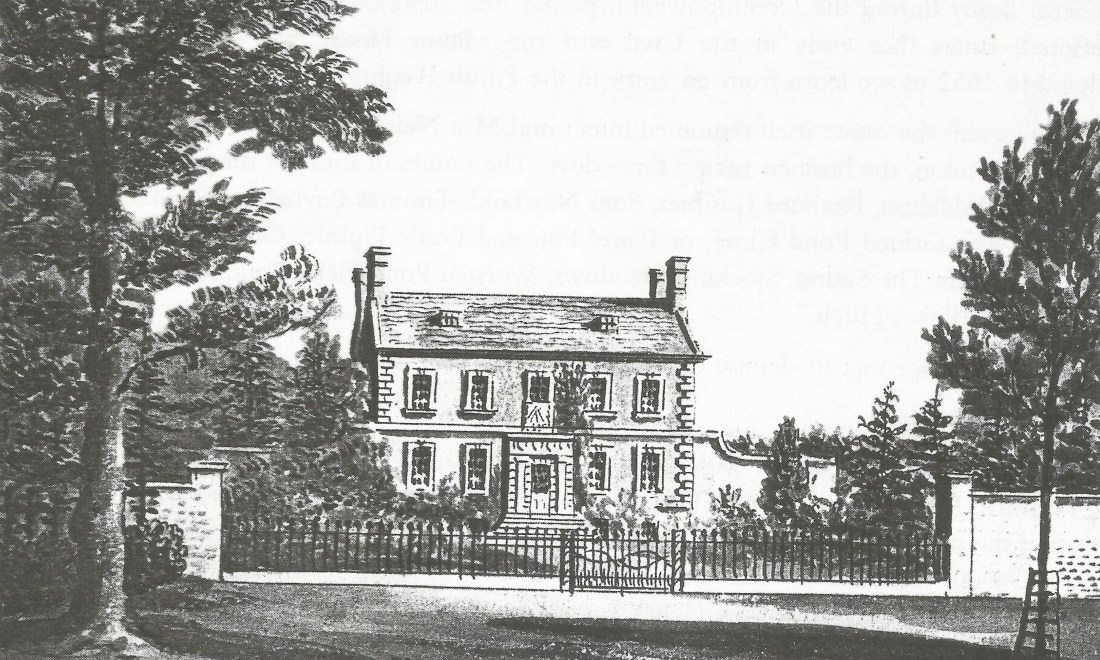
From a print lent by Tony Landon
The early 1900s – military men and merchants
Mr Jeyes was the brother of Philadelphus ]eyes who owned a chemist shop in the Drapery in Northampton. He was a ‘country gent’, sported a coach house and kept three or four hunters in the stables to the west of the Manor (now houses and garages). It was probably while the Jeyes family were in situ that a visit to Nether Heyford Church was arranged in 1906 by a local Architectural and Archaeological Society for the Archdeaconries of Northampton and Oakham as the Rector, the Rev H Isham Longden, was ‘a true archaeologist’ and a visit to the Manor House had been planned. But “time and the weather did not permit a visit” and instead they all headed back to the Rectory for tea presided over by ‘Mrs Crawley’.
After the Jeyes family moved out it was said that it was empty for a while, but then came the Muir family and documentation to this effect is available in the form of an Indenture made out in 1914 by John Buchanan Muir’s son Matthew Andrew which left everything to his wife, Jessie Agnes Muir, on the understanding she did not leave him, in which case she would lose the lot… What is interesting about this Indenture is that the Fee Farm Rent was still 3s.4d….
The Conveyance for the sale to the next occupant was dated 5th December 1919 and this was Lieutenant Colonel Livingstone-Learmouth who was based at the Ordnance Depot in Weedon and it is said that he had the house massively extended with new wings at each end. However it is more likely the East Wing was put on quite a bit earlier and the flat-roofed West Wing added during the first World War as wood was difficult to come by although one rumour has it that the occupant, a woman at the time – Mrs Muir? – could not afford a ‘proper’ roof .
The Manor house around the turn of the century
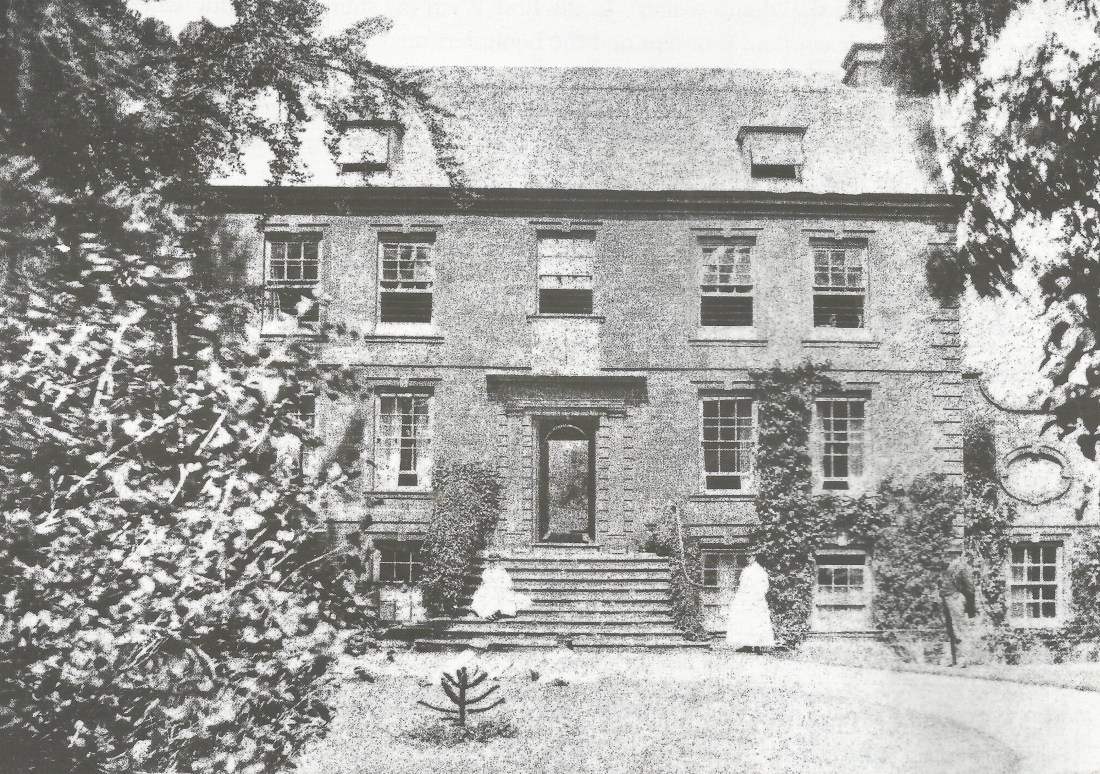
Gardens, stables and domestic service
But what we do know is that Frank Pearson’s parents came to Heyford in 1919, his father becoming Head Gardener at Heyford Manor until his death in 1948. Frank was born in the Head Gardener’s cottage which was situated backing on to the Churchyard and Frank himself helped his father in tending the Manor gardens. The earliest inhabitant of Heyford Manor Frank can remember was Brietmeyer “a big man who was very fond of hunting, which he enjoyed sometimes three times a week”. Certainly there are still memories in Heyford at the time of writing of the Master riding to Hounds and scattering coins to the children who had gathered in what is now Manor Walk to see this awesome sight.
But the Livingstone-Learmouth era (1920s and 30s) was probably the last of the ‘greats’ in the sense that here was a large Manor, acres of land, servants and a Head Gardener. The gardens, as remembered by Frank Pearson, comprised rose beds, rockeries, kitchen gardens,flower borders and grass walks, asparagus beds and apple stores and the horse and cart track led down to the ‘Coach Bridge’ and thereon down to the mill. Frank himself told of how he was responsible for raking the gravel drive in order to keep it tidy which ran by the existing boundary at the front of the Manor and on down to The Sun. At that time he said the servants used the West Wing and the ‘garden room’ there was the servants’ dining-room.
The whole of the bottom floor of the Manor was I believe devoted to kitchens and the old bread oven can still be seen in the middle part of the Manor – the little ‘Garden House’ at the back was reputed to be the dairy (although as the present occupants pointed out, strange that the dairy should be in the front of the building?) – and ladies from Heyford can remember helping out in these vast kitchens.
There is still an enormous cellar for the fine wines and the scribblings of the Butler above the store bins denoting the type of wine enclosed. The old bells to summon the servants are also still in place and until very recently so was the ‘dumb waiter’. In the East Wing the stairs to the attic where the servants slept are pitted with their constant footsteps and the bannisters uneven where they slid their hands down in their haste to attend to their duties. The attic roof was bare With no insulation but the coal fire must have been lit as there is an enormous chimney breast which goes through their attic rooms in order to give them some warmth. It must have been a hard life for the young girls who Would have been employed around this time.
But by now the First World War had struck, twenty three soldiers from Heyford losing their lives and Lieutenant Colonel Livingstone-Learmouth CMG, DSO, RHA unveiled the War Memorial in 1921 which stands on the green at the junction of four cross roads. The Rev Isham Longden conducted the service and amongst the names on the memorial is Captain T H O Crawley.
Bill Kingston remembers when there were no buildings between the Foresters Arms and Richard Denny’s house and there was a field stretching back to the Manor House in which the occupant at that time, Captain Shield, kept several hunters.
In 1928 another auction took place this time with only 23 acres attached, the land gradually being eroded by new buildings. This may have been bought by ‘the Diamond Merchant’. Unfortunately no other details as to this person emerges except he left strong evidence of his occupancy within the house itself!
For sale by auction – July 19th, 1928

From a newspaper cutting (source unknown) lent by Tony Landon
The Manor House and gardens as they appeared between the wars
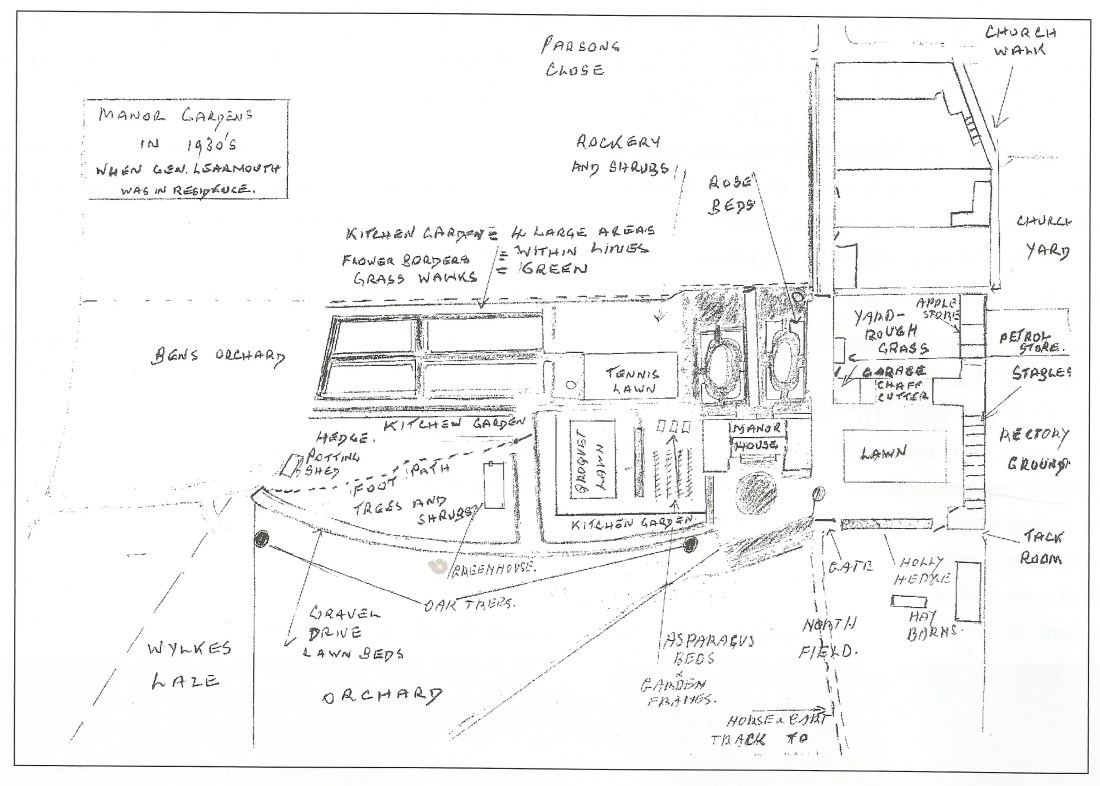
The surrounding fields
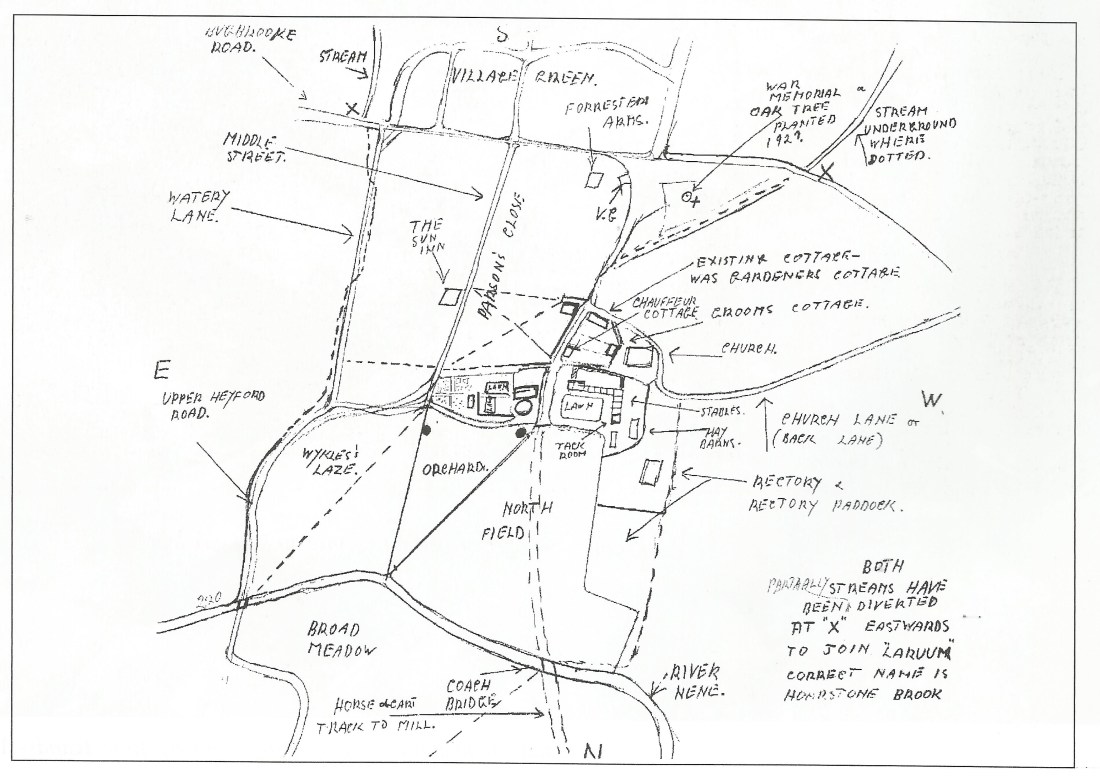
From illustrations made by the late Frank Pearson
The post-war years
During the Second World War soldiers were billeted in the Manor and on the West Wing ground floor there was a telecommunications room for use between Bletchley Park and Weedon, the room still being there and until recently with a complicated wiring system intact.
After the War the Manor House became a school for deaf children and according to Mary Warr (wife of the former Headmaster of Bliss School) in 1970 it was still listed under ‘Schools’ in the telephone directory… However, Raymond Wray, the present Landlord of the Foresters remembers clearly seeing a plaque on the Manor with ‘St Dunstan’s’ inscribed on it so it looks as though it was actually a school for the blind. But of course there may have been two types of school here.
In the latefifties the house was up for sale again – actually I’m guessing here. I have a copy of the details but no date, the only clues being ‘after the building of the M1 and before decimalisation’ – this time at £18,500 With 18° acres, having been subject to ‘considerable expenditure’, the agents being Knight, Frank & Rutley of Hanover Square, London. Here the Agent’s details reveal that the East Wing was entirely self-contained and used for staff only. And guess What? The Fee Farm Rent payable to the Queen is listed at – 3s. 4d. per annum…!
An aerial view of the house in the late 1960s
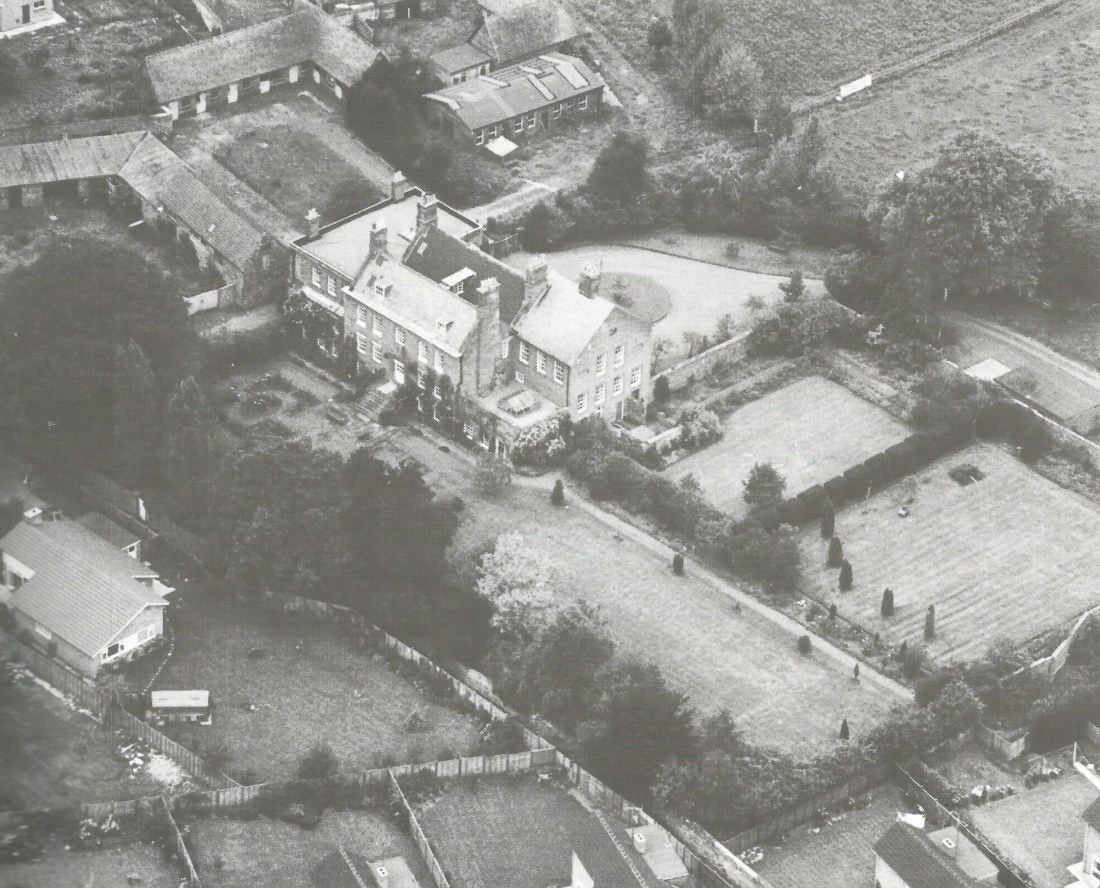
By the sixties the Manor was still intact but with even less land as an old aerial photograph shows the beginning of the new chalet bungalows in Manor Walk built on the grounds of the old Chauffeur’s cottage. And we know that at this time it was occupied by the Architect Mr D Harwin as he was responsible for a lot of the new bungalows materialising. Raymond Wray (at that time living in Flore) was, at twenty-seven, the General Foreman for one of Mr Harwin’s building firms and was responsible for the building of this new development and he is almost certain that it would have been Mr Harwin who purchased the Manor for the sum of £18,500.
Separate dwellings
Then in 1975 with the rising tide of up-keep costs, the Manor and all its remaining land was sold to Cooper Construction Ltd of Lichfield for a housing development known now as Manor Park. Fortunately many of the trees were given Preservation Orders (the Manor itself is a Grade II listed building) and a fine old oak and many Scots Pines stand proudly still, including a very old apple tree which would have been in the old orchard near the stables and garage block.
And the Manor House became divided into three dwellings. The frontage which sports a beautiful old sundial and small oval windows became the back and the large grassed circle. the front of the Manor. The land which swept down passed the Horestone Brook and across the Nene was now all taken up with the new development. Its Glory Days were indeed over! Manor ‘Walk became built up with even more new houses but Manor Cottage — the old Gardener’s Cottage – is still there and other cottages dotted around Manor Walk and others backing on to the Churchyard still look much the same as they did when they belonged to the Manor and its estate. And although the drive that swept through Manor Park and through to Middle Street has long gone, one of the pillars which marked the entrance is still there at 15 Manor Park in Bernard Carpenter’s back garden…
Michael N Harbour, a former member of Northampton’s Royal Theatre Company bought the East Wing and was especially delighted when the BBC offered him a leading role in ‘A Last Visitor for Mr Hugh Peter’ as it depicted the story of Cromwell’s chaplain who is spending his last days after being imprisoned by the Royalists. The Battle of Naseby took place about ten miles from the Manor and Michael believes dead bodies could easily have been buried at Nether Heyford as the soldiers returned to London. Another bit of history to add to the already long one of Heyford Manor…And we mustn’t forget a piece of recent ‘history’. In the Great Northampton Floods of Easter 1998 both the East and West Wings were flooded when the River Nene broke its banks — the worst floods for over a hundred years.
Tony Landon bought the main part of the Manor and skillfully finished converting it into a period home for his family, and the Rands-Allens (appropriately hyphenated) bought the East Wing from Michael Harbour where they have lived for the past seventeen years. Gill and Tony Pont and their family live in the West Wing, keeping all of the original features, having been there for fourteen years, and Wayne and Ann Edmonds live in the little studio at the back which Michael Harbour built and lived in for a time before moving to London. Unfortunately there appear to be no sightings of ghosts from any of the occupants.
With all its history, both actual and imagined and with all the changes the years have seen, one thing remains constant. Families have lived in the Heyford Manor House over the centuries, are doing so now and will continue to do so over the Millennium and far beyond.
Julie Rands-Allen (with a little help from some friends!)
Article updated for the years 1947-1956 in Volume 4 Chapter 6:
The Story of Heyford: The Manor House 1947-1956 V4C6
~~
Extract from “The Story of Heyford” – Local book series published in the late 1990’s
Volume 2 of 4 | Chapter 5 of 11 | Pages 9 to 17
Growing up in Nether Heyford
I was born at No 3 Furnace Lane in 1946 and lived there with my patents until 1969 when I got married. My father was the eldest of 7 children in the Collins family, living at ‘Wharf Farm’, Furnace Lane where my aunty still lives. Lower Heyford, as it was known then, changes its name in later years because the village was often mistaken for Lower and Upper Heyford in Oxfordshire, where the air force is based.
My mother originated from Harpole, and she met my father at the ‘Heyford Feast’ and got married, living in Heyford for the rest of their lives. Heyford Feast was a long standing event. It always fell on the 11th October each year and consisted of a large fair on the village green with Swing Boats, Carousels and Dodgem cars, not to mention Roll the Ball, Shooting and many other amusements. Also, lots of stalls selling candy floss, hot dogs mint humbugs etc. The fair was run by the Abbott and Billing families and over the years we got to know them well and while in the village, their children attended our local school. I went to Heyford School when I was five years old and was educated by Mr & Mrs Woods, then by Mr & Mrs Warr. The school bell was rung twice a day at 9.00am and 1.00pm just as it is today. Although other nearby villages had their own feast dates, Heyford was the largest because of our fabulous village green. People used to come from miles around and Tom Rolfe, who ran the Foresters Arms, opened up the club room for dancing which went on late into the night.
We also had a very good Youth Club which was held in the village hall. I was club secretary and my friend Lynn was treasurer. The fee was 2 old pennies per evening and we often had an awful job getting the money in. We had regular dances, often on a Friday night with live groups. People came from all the nearby villages and Northampton and they proved to be very popular. As club secretary, I had a hand in arranging these events.
I have many things I remember about life in the village. A lot of my leisure time was spent with my cousins on my grandmothers farm, especially in the school holidays. My dad’s youngest brother, Reg and his wife Joan, helped my Grandmother on the farm and lived there with their four children. In the school holidays, my two eldest cousins and I would help out ad played for hours in the hay barns and fished in the nearby canal. The railway line ran next to the farm and we would go into the signal box with the signalman and watch the trains going by. If we were lucky, he would let us pull the levers to change the signal.
Haymaking was always good fun too. My uncle would put the bales on his trailer which was then hitched up to the tractor and us children would stack them in neat rows, getting higher and higher as we went. Then we would sit on the top with my uncles towing the load back to the farm. (This would not be allowed nowadays).
My father, Arthur worked at the Northampton Power station as a fitter until he retired. He was one of the many volunteers who helped build the village hall, giving up their free time whenever they were able to.
Also, in the school holidays I would go with my mother fruit picking on Mr Beck’s farm. He would come into the village with his tractor and trailer to pick up the many helpers (mostly women) to take back to pick the fruit off his many currant bushes and other fruits. At the end of the day he would transport everyone back into the village. He lived on the large estate when New Creation farm is today.
When my parents married, they lived in a small rented house with no amenities, no running water and an outside toilet. One of my lasting memories of this, is having local men come round on a regular basis with the ‘Muck Cart’ to empty the bucket. (No such luxury of a flush toilet). On one occasion I was sitting on the toilet as a young child and they arrived to perform this delightful deed. I shouted through the door, “I haven’t finished yet”. Back came a very calm reply from one of the men, “It’s alright my duck, I can wait”.
Mr Faulkner, the baker delivered the loaves of bread to various houses. It was always in the evening as he baked the bread first in Northampton. He would sometimes stop and chat and on many occasions my mother used to say, “When is he coming as I want to go to bed”. Suddenly the kitchen door would open, and a hand and arm would appear clutching the bread, put it on a chair by the side of the door and say “Coo-Eee” and he was gone in a flash. Thus, he was known as Coo-Eee The Baker. At Christmas time, it was even later, as many customers gave him a drink or a mince pie, and he would be a little worse for wear when he arrived.
Eventually, my parents were able to buy the house we lived in together with the one next door, after John Earl (who owned the property) died. They had the two knocked into one and modernised, and it still stands today.
After I left school, I went to work at the Express Lift Co in the office. This is where I met my husband, Bob. We got married in 1969 in the Baptist Chapel and bought a new house in Rolfe Crescent, which is on the Wilson Estate where we had two children, Christopher and Anna. Twelve years later we moved to our present home in the centre of the village, where we live today. Both our children are now married, and we have four delightful grandchildren, two of which attend Heyford School. This makes them the fourth generation in my family to go there.
I have lots of fond memories of living in this wonderful village, which has grown tremendously over the years with the Village Green as its heart. School sports, football and cricket matches were played on the green before the arrival of the playing fields, which all the village folk would turn out to watch regularly. John Smith’s cows would often escape and go charging over the green with John running frantically behind. Some people now refer to the green today as the park, but to us oldies, it will always remain our beloved village green.
I hope you’ve enjoyed my little visit down memory lane as much as I have.
Jenny Lewis
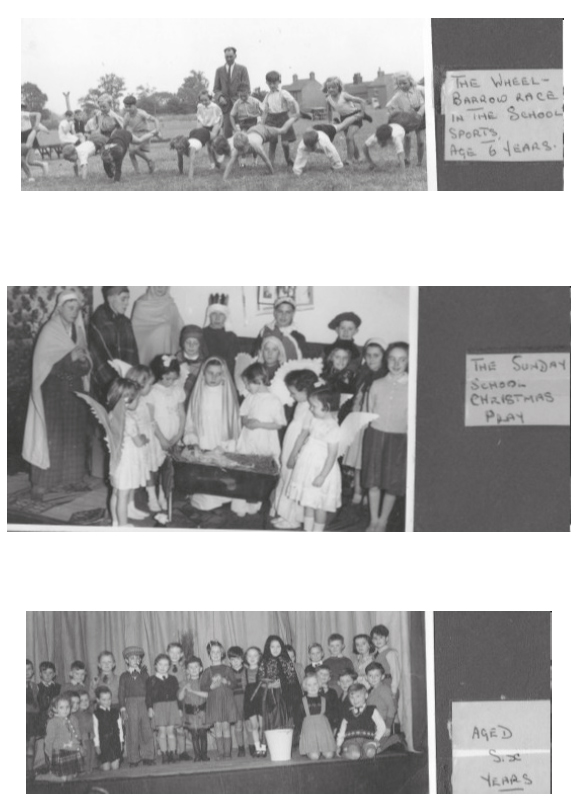
Letter published in The Prattler – December 2019
Heyford Feast
The fair has been coming for Heyford Feast in October for as long as anyone can remember. Heyford Feast is the anniversary of the dedication of our Parish Church and takes place on the first Sunday after the 11th October. This is also the time of year when Harvest Festival activities took place – they continue to do so today — marking Heyford as one of the churches to celebrate Harvest late in the season.
The fair and the church’s celebrations were closely linked: together they formed the greatest village occasion of the year and would last one week. In the early 1900’s, the fair families attended Evensong at the church and contributed some of their takings to the collection. Today, there is no longer a link between the church and the fair but this still remains the time of year when the fair comes to Heyford.
When the Parish Council was originally set up in the late 1890’s, it stated that no fairs could use the main part of the Green. However, by then, the fair was so much part of our tradition that this ruling was later rescinded. It was a major event to be shared by all and men employed locally were often given the Monday off work to be able to enjoy the festival to the full. Likewise, pupils at Bliss School were allowed the Monday off in order to meet the fair at Upper Heyford and walk down with it into the village.
After Heyford, the fair went on to Daventry to become the centre for the ‘Mop Fair’ – so called because it used to be a time for hiring domestic staff This was at the turn of the century when fairs were still more business and trading occasions than anything else. Workers would advertise their availability for hire by standing with mops in their hands. It was a big occasion there too, and the fair would block the main roads in the middle of Daventry.
Swing-boats and roundabouts
Bob Browning recalled the fair in the village from the early 1900’s. There were swing-boats and roundabouts with wooden horses and most rides charged 1d. All along the road from the Post Office to the schools were stalls: coconut shies, hoopla and darts. Fred Browning remembered the game of Aunt Sally in which you had three balls for one penny and had to throw them through a hole in a door to release ‘Aunt Sally’. There was no prize in succeeding, just the thrill of seeing Aunt Sally appear. Fred even commemorated the fair in verse as part of a poem called “Heyford Green”:
Remember the fairs, wooden horses and wares
would collect to the joy of us all…
By contrast to such ethereal thinking, The Foresters pub was central to the fair’s activities because of its place on the Green and it wasn’t unusual for there to be fights there.
Great anticipation
Many villagers can still recall the fair from the 1930’s and 40’s. There was great anticipation for its arrival. The children would save up money for weeks beforehand and girls sometimes knit purses to hang around their necks with the three or four pence saved for the rides. They gathered rose hips which they could sell through the school for 3d. per lb. for making rose hip syrup. They would also collect acorns from ‘accern orchard’ which they could sell as pig fodder. Some people would collect eating apples which the fair folk would buy for making toffee apples.
On the day of the fair’s arrival there was great excitement. School children – now no longer allowed out to greet it – would often hear the fair setting up on the Green across the road. This caused them enormous frustration because they were all itching to get out and see it. If the fair happened to arrive out of school hours, the children would go to meet it along what is now the A45. They would put their ears to the ground to try to pick up the vibration from the rumble of the steam engines.
The Steam Engine
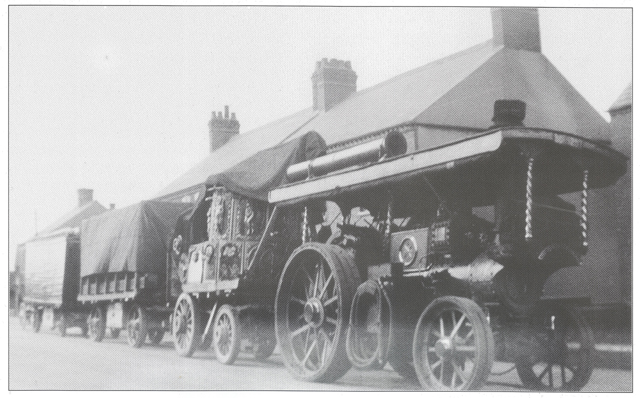
This photo, taken in the 1930’s, possibly leaving Finedon, shows George Billing’s Burnell 2625 ‘Lady Pride of England’
Photo lent by Ted Garrett
George Billing
The fair was run at that time by George Billing. He wore a bowler hat and a navy blue suit and his wife collected the money in great heavy bags full of pennies. The fair would set up near the shops and The Foresters and the main attraction was the merry-go-round. It had horses on the outside, cockerels in the middle and smaller horses on the inside. It had its own steam engine to drive it and George Billing stoked up the fire to keep it going. However, sometimes the steam would give out and the children would push the merry—go—round around by hand.
The other main attractions were the big swing boats at 1d. a go. There were many battles to see who could take their boat the highest and the fair people got cross if anyone tried to swing their boat right over! There were stalls for the coconut shies, darts, roll—a—penny and skittles. The skittles were tall and white – four in a line – and the prize for knocking them all down was a packet of nuts or Players cigarettes.
The fair also made its own sticks of rock known as ‘Feast Rock’. It was humbug flavour and striped brown and yellow. The rock stall made it by hand by pulling the sweet mixture out into long strings. By all accounts it was delicious!
Horses and steam
Two traction engines were operated by the fair. The larger one stood up by the Baptist Chapel and generated electricity needed for the lights. As there were still only gas lights in Heyford at the time, the electric light display on the Green was rather a novelty. Hilda Collins remembers how the steam engine would stand on its own beside the chapel, chuffing away: “There were clouds of steam and it would be spitting scalding hot water – quite dangerous really!” She also recalls the organ on the roundabout and how, as children, they would ride round and watch the different instruments ‘play’ in turn in the centre of the ride. The roundabout organ used a pianola device of perforated cards that played the music and – being limited to the number of cards the ride had – the same tunes would start up over and over again.
All the caravans were horse drawn and were set up in a row. At first, water for the fair had to come from a private supply but then the fair people used a public tap that was set up on the Green opposite the Denny’s house. The tap was spring—loaded, i.e. it required you to hold the tap open all the time otherwise it shut itself off again. The fair’s horses were left to graze in a nearby field or in the hollow at the far end of the Green.
When The Foresters closed at 10:30 pm each night, some men came out rather the worse for wear and would head onto the fair site. On occasion, George Masters and Herbert Clarke – both big men — came out of The Foresters and climbed up on one of the horses waving their hats and shouting “giddy-up.” Albert Garrett recalled how once, so many men came out of the pub and clambered onto the merry-go-round that it wouldn’t start. George Billing is remembered for throwing his hat on the floor and pleading with some of the men to get off.
When the fair finally closed around midnight, the last tune played on the steam organ was ‘Christians awake, salute the happy morn’ – Mrs Billing’s favourite tune. When it was all over, the children walked around looking for halfpennies and pennies that had been dropped in the grass. It wasn’t unusual to find threepence or sixpence, which was a lot of money in those days.
The Abbotts and Thurstons
After the Second World War, the Abbots brought the fair and they continued coming for another thirty years. The fairground attractions essentially remained the same, but the Abbots introduced the dodgems. The steam engines were eventually replaced by diesel and by the 50’s, the horses were replaced by vehicles.
The fair continued to be very popular and is remembered for being very crowded during this time. Many families had relatives coming to stay with them for the duration of the fair and Heyford Feast. It was also an attraction to other villages in the locality, for although the fair moved on from Heyford to Bugbrooke for a time, the site in Bugbrooke (a field on the outskirts) was not considered very suitable. Hilda Collins remembers how, on the Green, you could hardly see the stalls for the crowds of people around them. If the fair is quieter today, it is probably to do with easier access to the larger towns and the development of Northampton’s own autumn funfair.
While the fair was at Heyford, the fair children would attend Bliss School. This included old Mr Abbot’s daughter, Norma. In 1971, she married William Thurston from another fairground family and in the following year, the fair began coming under the Thurston name — as it still does today.
Around that time there was debate about the positioning of the fair on the Green. Its site near the shops was considered disruptive because of the noise and there were also complaints about the state of the football pitch on the Green after it had gone. For a time the Thurstons alternated year by year from one end of the Green to the other. Eventually they settled on its present location opposite the school.
Mary Warr, who wrote about the fairground family in her short history of Heyford published in 1970, had a far rosier view of the impact that the fair made on the village. She said, “For as long as we have been here (1953-70) the fair has been in the family. Older villagers have seen the fair people growing up and there is much friendship. I can only speak of my own experiences. We have nearly always had the fair opposite the school and have always known them to be friendly, considerate and peace—loving visitors. At night when the fair closes down, all is quiet and nothing happens to disturb our rest. I hope this wonderful relationship continues. Our places of worship have been visited by them and they have given generously to us on occasions.”
The fair in 1998

Photo lent by Stephen Ferneyhough
Nowadays the fair continues to be assembled on the middle section of the Green and it is always tidy and compact. The Thurstons bring only a selection of their total fairground equipment because they do not stay many days and space on the Green is limited. They bring the Waltzer, two or three ‘children’s rides including a helter-skelter, a range of gaming machines in an amusement arcade and a variety of side stalls. The Thurstons are based in Wellingborough with a season that runs from March to November, touring all over the East Midlands and East Anglia. Then during the winter months, they do all their rebuilding and maintenance work. William Thurston’s grandson is the seventh generation in his family to work the fairgrounds.
Sarah Croutear with contributions from Hilda Collins and Ted Garrett
~~
Extract from “The Story of Heyford” – Local book series published in the late 1990’s
Volume 4 of 4 | Chapter 4 of 8 | Page 18 to 21
Until the second world war, the village was largely a rural community and the population had been slowly declining. The school had been rebuilt in 1880 to accommodate 170 children at a time when the population was about 800. By the early 1950’s the population had fallen to 700 and the average attendance at school was only 70. This reflected not only the smaller population, but also the reduction in the proportion of younger people. The post war baby boom hadn’t yet hit us. Therefore Heyford in the 1940’s and 1950’s was taking on the profile of an ‘elderly’ village. An article in the Mercury and Herald in November of 1969 recorded that there were 24 residents in the village over the age of 80.
With the end of the war, young people were finding it increasingly difficult to get work in the village or to afford housing. The farms were becoming more mechanised, and the small cottage trades were being replaced by large new businesses such as British Timken which enticed the young men away with modern working conditions and good wages. The young people were therefore beginning to find work and homes outside the village.
Some of the older buildings were becoming derelict and uninhabitable. Many of the old stone and thatch buildings were demolished and replaced by modern homes. These included three cottages on the far side of the green where Pound is now situated, four cottages at the bottom of Furnace Lane, Mrs Lilleys cottage between the Post Office and Methodist Chapel, and Brook Farm. On reflection it seems sad that we weren’t able to preserve these buildings. However some of the older residents recall how they didn’t always live up to their chocolate box image. They were often dark, damp, and infested with mice. Houses like this were expensive to maintain but the families that occupied them didn’t necessarily have the funds to do it. It was therefore quite understandable that people wanted to swap them for the modern comfortable housing which was becoming readily available. During the 1960’s the village began to change dramatically.
HEYFORD TOWN
Seems unbelievable, but could be true, and wouldn’t it be a pity;
In fifty years our little village could become just like a city!
Written in 1983 by Gordon Hayes of Close Road
Mary Warr’s ‘Diary of Change’
The following notes were made by Mary Warr while she lived in the village. She was the wife of George Warr who was headmaster from 1953 until 1975. Mary also taught at the school. Although they were ‘outsiders’ they spent many happy years in the village and became well respected members of the community. They took a leading role in a number of activities in the village including the Scouts, the WEA, the Library Service and the Theatre Club. During their time in Heyford the village changed enormously, and Mary kept hand-written notes of the changes as they occurred in a school exercise book which she later donated to the record office at Wootton Hall. The following notes are taken largely from that notebook.
‘We came to the village in 1953. The council houses in Furnace Lane and Church Lane, originally built in the 1930’s, were being modernised. Rayburn cookers were put in, along with bathrooms and deep drainage. In those days a cart called at many houses to collect the toilet contents.
In December 1953 Mrs Hazel left the school after many years service. In January 1954 the school children helped to plant trees in Coronation Avenue.
The council began to plan and build houses up Hillside Road and Hillside Avenue, and afterwards the cottages at the corner of Close Road were demolished. In the same year water sanitation was put in the school.
In 1956 the school was rewired for electricity and repainted – bright colours this time. Also the senior children were removed and the school became a primary and infants school. All the classrooms had new floors, and the hall was built during this time.
In 1962 plans began to ‘make haste’ for the change from village street gas lighting to electric lighting. Electric lighting became a fact in September 1963.
In 1964 the village began to grow quickly. We had watched Mr and Mrs Cowling ’s dormer type house grow next to Mrs Smith’s farm.
Old cottages on the site of The Pound around 1900.
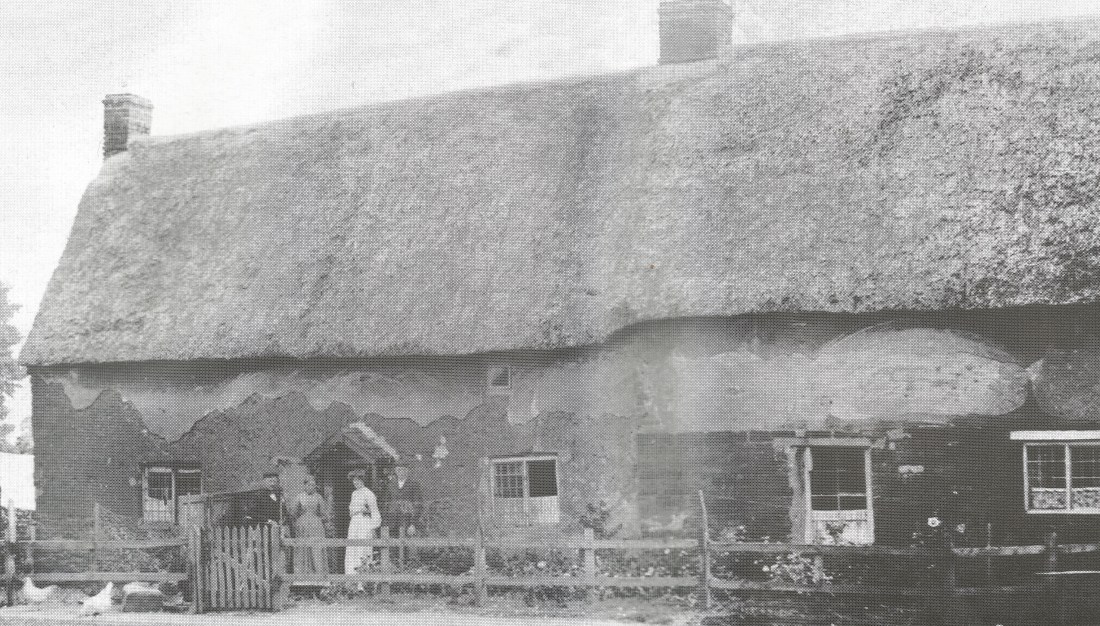
Photo lent by Charlie Copson
Mr Harwin at the Manor House began to build in the Manor field – Church Close. Now we can only dream of the buttercup field across which we brought the children back from church every other Ascension Day. The first people to move in were Mr and Mrs Buck and their son William whose bungalow is next door to Mr and Mrs Denny (the builder and his wife).
In Manor Lane there are now houses too. At the end of 1964 houses up Furnace Lane next to Mr and Mrs Buck were built and inhabited.
In 1965 building work started on the field between Mr and Mrs Lilley and Mrs Jones. Two houses originally thatched next door to Mr Watson’s shop and the jitty were pulled down and rebuilt by the council.
Work is contemplated by Adkins and Shaw for houses in the Brook Farm Field, now owned by Mr Frank Hodgkiss and originally belonging to Mr Whitton.
In 1964 / 1965 houses were also erected along Bugbrooke Road, the first built for Mr Watson and his family next to Mrs Smith’s mushroom field.
Mrs Potter’s field was for sale in Church Lane in 1965 and it still remains to be seen what happens there. Two council houses built in 1965 to replace four thatched cottages on the green next to Mr Watson’s.
In May 1966 the village has changed its character. The field in front of Brook Farm is being built on by Adkins and Shaw. Houses are going up opposite too along the Bugbrooke Road. By the Rectory in Mrs Potter’s field are standing two bungalows built by Adkins and Shaw. There is to be a new Rectory in the Rectory gardens.
Mr C. Denny has built a new bungalow for his own occupation between Sunnyside and Miss Eales’ house. Furnace Lane has its quota of new houses on both sides now, and Middle Street has new houses from Mrs Buck’s down to the corner of the field. Only one space is left and the road has yet to be built in this area.
In the far corner of the field by the manor one house is inhabited and there is a right of way across the field from that corner to Middle Street. How we miss the freedom of that buttercup field.
The four thatched cottages in Furnace Lane pulled down in 1965
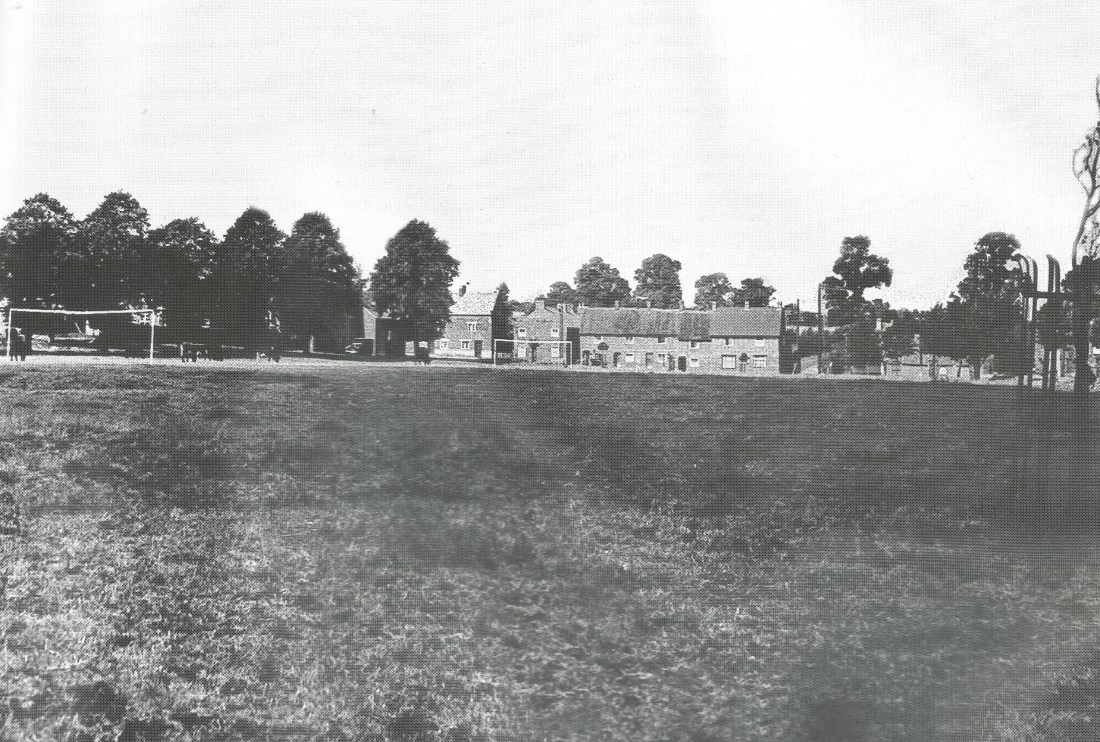
Photo lent by ]udy Armitage
It is rumoured that Mr R Adams is going to sell yet another field and 100 houses are to be built. Ben’s Orchard is for sale – three plots – and three houses or bungalows are to be built in the Manor garden.
Middle Street is to be a one way street to Upper Heyford, and Watery Lane is to be widened to take the the traffic from Upper Heyford.
The Youth Club is now quite at home in the old Methodist chapel which was formally opened in the Autumn of 1965. Adjoining it, Mrs Lilley’s old thatched cottage, now belonging to Mr and Mrs Blaney is derelict. The thatch is falling off, the chimneys look very dangerous, and it looks as though all might collapse like a pack of cards.
The Post Office was moved from the corner to a cottage nearby just before Christmas, also the letter box, and the name of the village from January 1st became Nether Heyford.
A factory – light engineering – is to be opened at the furnaces and local labour will be used. At the parish meeting early this year it was proposed that seats should be erected on the green. Now, May 25th, they are still not there.
People have been turning out at night to hear the nightingale in the Furnace Lane direction. We are getting much more traffic in the village. It is hardly safe for dogs to be loose. People are getting used to seeing roads up – pipes, gas and electric cables have to be laid.
Mrs Potters field in Church Lane before the houses were built

Photo lent by ]udy Armitage
The small Heyford family is definitely having to get used to living with strangers in its midst. Meanwhile one can only conjecture on what will be the effect. It is quite true that nobody now seems to know everybody else. The intimate feeling of knowing our village is disappearing.
May 1967. Houses have been built in Church Lane, Wakefield Way (Mr Hodgkiss’s), Winston Close, Furnace Lane, Middle Street, Manor Walk and Weedon Road. And now building operations commence at the end of Close Road (Wilsons estate). I have lost count, and without walking round or consulting records I cannot estimate how many.
The A45 dual carriageway from Upton Mill to the Heyford flyover has been built this year. It is 3 miles long and cost £520,000
We ourselves, March 1967, have formed a Theatre Club and have 34 members. We are all set to visit the Shakespeare Royal Theatre on June 22nd to see “All’s Well that Ends Well”.
July 1968. Bugbrooke secondary school is now open. For the first time in 16 years a Parish Council election was held. All the members are Old Heyfordians. This I think is a pointer to the resistance the newcomer must meet.
A view of Watery Lane before its development in the 1960’s.

Photograph lent by Mrs Searle
February 1969. It has been impossible to keep pace with all the buildings in the village and do my job as infants teacher. In Middle Street all the lovely trees were cut down in 1968. The school extensions started last year in March and we are now using our new hall. The Wilsons estate grows apace and so does Hillside Crescent and Winston Close.
People come and go. There is a flourishing play group for pre-school children. The WEA group is strong, and my own Theatre Club is now affiliated to the Arts Council.
The shop changed hands from Mrs Blaney to Mrs Eales. Mrs Blaney still has the post office, helped by Miss Humphrey. Mrs Lilley’s old cottage has been partly demolished to make it safe. Middle Street is being widened as far as the bridge and we now have a pavement opposite the School House.
1969. The new Rectory is being built. The school dining hall and kitchen were completed in January. Five Georgian houses have been built in Manor field . Mrs Lilley’s old thatched cottage has been razed to the ground. There is a building site at Brook Farm. There are buildings now on both sides of Middle Street and in the river field near the Manor. Mrs Highfield sold her shop. There is now a Green Shield Stamp shop to compete with the VG stores. John Haynes and his wife live at the post office and his wife helps Mrs Blaney. The Monday Club has been formed – it seems for young newcomers and their friends. The Youth Club is to be revived.
1970. A children’s playground committee has been formed. The brook has been dredged. The river has been dredged. Brook: Farm has been demolished in Watery Lane, and Middle Street has been provided with pavements.’
Mary Warr
The Memorial Green.

Photo lent by ]udy Armitage
The photograph above, lent by ]udy Armitage, was taken in the 1940’s. Towards the right behind the telegraph pole is the old thatched post office, demolished in the early 1950’s and replaced by the modern stores. In the centre behind the tree is the original Methodist chapel built in 1838. To the left of this is the thatched house occupied by Mrs Anne Clarke, Heyford’s midwife in the early 1900’s, and later by her daughter Mrs Lilley. This house was demolished in 1969.
HEYFORD’S BEAUTY
Of bureaucratic interference, no one is deserving,
But certain things in Heyford are truly worth preserving.
John Smith’s lovely farmyard, the school, the village green.
If developers ever get them, they’ll be no longer seen!
So the word ‘conservation’ should never cause a frown,
Let’s keep those lovely treasures so there’s something to hand down.
Gordon Hayes, 27th October 1983
~~
Extract from “The Story of Heyford” – Local book series published in the late 1990’s
Volume 1 of 4 | Chapter 10 of 13 | Pages 24 to 29